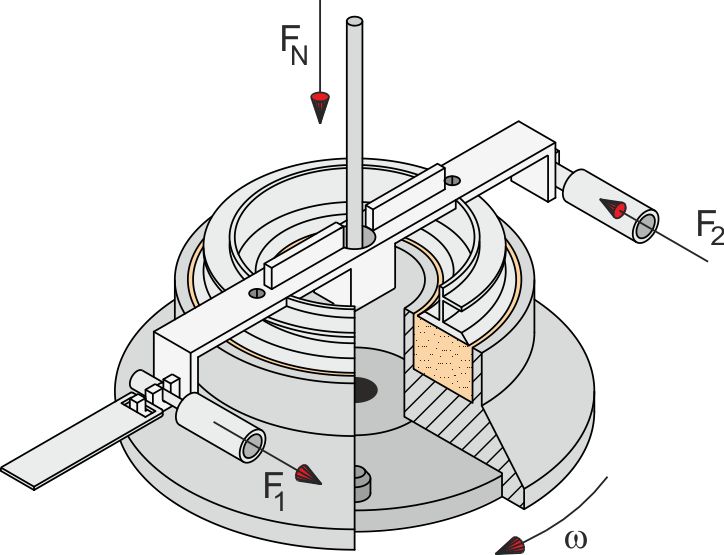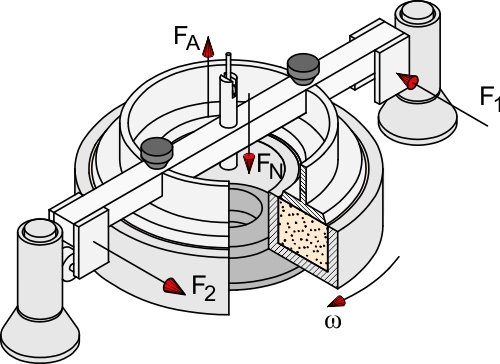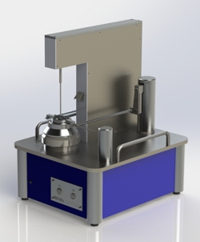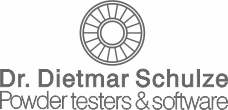
Application and overview
Ring Shear Testers serve for the determination of flow properties
of powders and bulk solids like pharmaceutical powders, flour,
cement, soap powder, titanium dioxide, clay, sewage sludge, and
others. Thus, a Ring Shear Tester may be called a powder tester,
powder flow analyzer, bulk solid flow tester, or flow property
tester, and sometimes it's called a shear cell tester or just ring
shear cell. However, being a real shear tester, the Ring Shear
Tester is a very accurate powder tester providing physical
quantities to characterize powder flow. Results can be applied on
product optimization, quality control, or characterization of
powder flow, but also on quantitative design procedure like hopper
design for flow. Thus, our Ring shear testers are applied in
a wide range of industry (e.g. Chemical Industry, Pharmaceutical
Industry, Food Industry), and in universities and research
institutions as well.
The most important flow properties of powders and bulk solids are:
Flowability, compressive strength, internal friction, time
consolidation, wall friction, and bulk density. These are
important (and physically-defined) quantities for the
characterization of powders More about these terms you will find
in an essay on this website (click
here) and - somewhat shorter - on an information sheet which
can be downloaded here as pdf file.
Typical applications for the ring shear testers are product
characterization, quality control, comparative tests, and silo
design.
An impression of the operation...
... of a Ring Shear Tester is given by the following example:
Small and large Ring Shear Tester

The principle of both Ring Shear Testers is the same: A
powder or bulk solid specimen is contained in a ring-shaped
(annular) trough, called the bottom ring, covered by an
annular lid and subjected to a vertical load through the
lid. The specimen is then subjected to a shear deformation
by rotating the bottom ring relative to the lid. From the
normal stress and the shear stress measured following
different procedures a couple of quantities is determined,
e.g., the unconfined yield strength (compressive strength),
the flowability, the internal friction, the bulk density.
The major difference between the testers is the size of the
shear cells. which determines the maximum particle size that
can be tested. This limitation results from the conditions
that a sufficient number of particles must be contained in
the shear cell to obtain a continuum, i.e., a "powder"
or "bulk solid" instead of "some particles".
If the materials to be tested do not contain particles
greater than about 1 mm, the small tester is sufficient. If
larger particles have to be tested, the large tester is
preferable. Since the maximum particle size is the critical
point, it is no problem to test very fine particles in the
range of micrometers or even nanometers in a large
tester.

The selection guide shows further criteria to identify the best
tester for your application:
Ring shear tester RST Mk II
 The Ring Shear
Tester Mk II, successor type RST-01.pc, is suited for all
powders and bulk solids up to a particle size of 5 .. 10 mm
(depends on particle size distribution). It performs the tests
automatically, i.e. controlled by a Personal Computer and
control software RST-CONTROL.
The Ring Shear
Tester Mk II, successor type RST-01.pc, is suited for all
powders and bulk solids up to a particle size of 5 .. 10 mm
(depends on particle size distribution). It performs the tests
automatically, i.e. controlled by a Personal Computer and
control software RST-CONTROL.
The RST Mk II is our most versatile tester due to the
possibility of measuring powders and bulk solids with particle
sizes from "0" to several millimeters. Thus, it is
advantageous in areas where not only fine powders are to be
tested, e.g., in silo construction and in the areas of food,
feed, chemicals and raw materials.
Ring shear tester RST-XS.s
 The "small" Ring
Shear Tester RST-XS.s is first of all an automatic flowability
and caking tester for fine-grained powders. If is a bench-top
device, much smaller than the RST Mk II, and serves as
flowability and caking tester at many places, but is also used
for the design of hoppers and silos.
The "small" Ring
Shear Tester RST-XS.s is first of all an automatic flowability
and caking tester for fine-grained powders. If is a bench-top
device, much smaller than the RST Mk II, and serves as
flowability and caking tester at many places, but is also used
for the design of hoppers and silos.
The RST-XS.s is usually placed on a laboratory bench and is easy
to operate. Because of the small required powder specimen (only
about 30 ml for the standard shear cell, about 3.5 ml for the
smallest shear cell) this tester can be applied also in
industries where only small amounts of powder are available for
testing, e.g. in Pharmaceutical Industry.
Why don't we call the Ring Shear Tester "powder
rheometer"?
We deliberately do not use the designation "rheometer". A ring
shear tester, or ring shear cell, is a shear tester. Shear
testers for measuring the properties of powders and bulk solids
originate from the scientific work of A.W. Jenike, the founder
of modern bulk solids technology.
A good shear tester is optimized to have accurate control over
stresses (e.g., applying a constant normal stress), and then to
measure friction (or strength) as accurately as possible. In
strength measurement, a powder or bulk solid is first
consolidated with the shear tester, then set to flow while the
shear stress required to initiate flow is measured. This gives
us information not only on flowability but also to the physical
quantities required for quantitative hopper design (mass flow,
no arching, no rathole formation), and also for structural silo
design.
In contrast to the typical rheometer, which is historically used
to measure properties of fluids, e.g., viscosity, the shear rate
plays a minor role in the shear tester.





